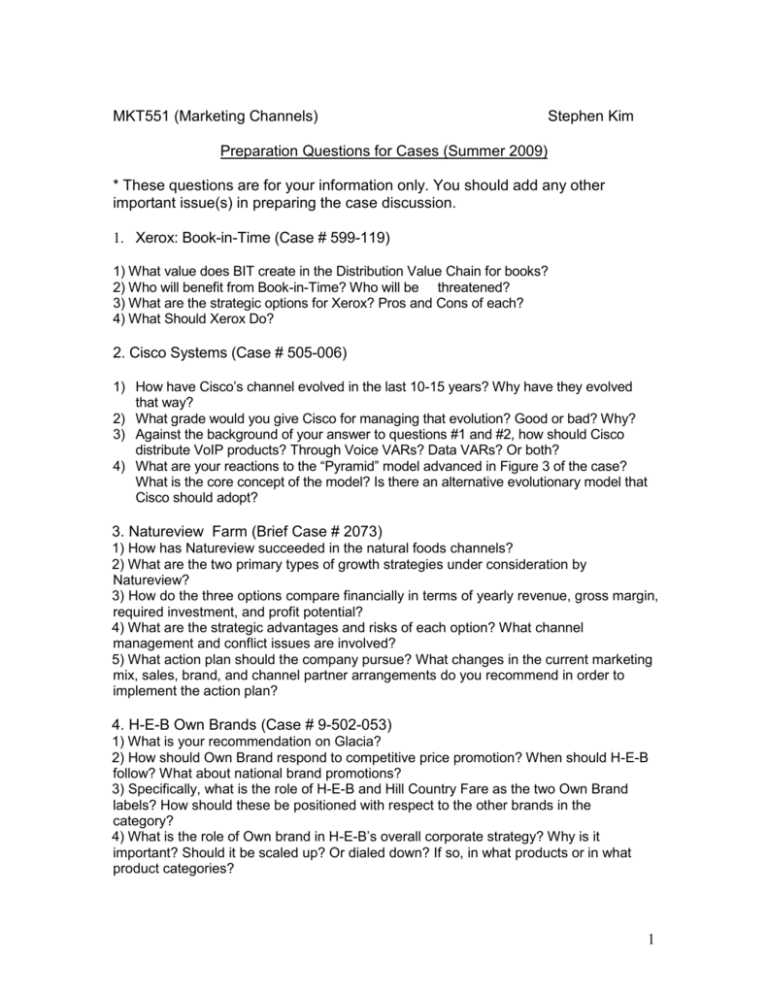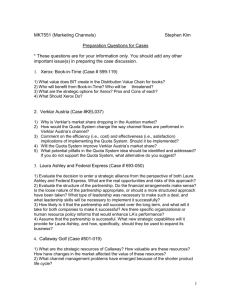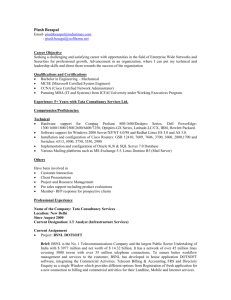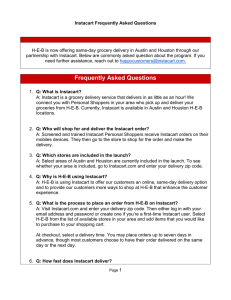Summer 2007
advertisement

MKT551 (Marketing Channels) Stephen Kim Preparation Questions for Cases (Summer 2009) * These questions are for your information only. You should add any other important issue(s) in preparing the case discussion. 1. Xerox: Book-in-Time (Case # 599-119) 1) What value does BIT create in the Distribution Value Chain for books? 2) Who will benefit from Book-in-Time? Who will be threatened? 3) What are the strategic options for Xerox? Pros and Cons of each? 4) What Should Xerox Do? 2. Cisco Systems (Case # 505-006) 1) How have Cisco’s channel evolved in the last 10-15 years? Why have they evolved that way? 2) What grade would you give Cisco for managing that evolution? Good or bad? Why? 3) Against the background of your answer to questions #1 and #2, how should Cisco distribute VoIP products? Through Voice VARs? Data VARs? Or both? 4) What are your reactions to the “Pyramid” model advanced in Figure 3 of the case? What is the core concept of the model? Is there an alternative evolutionary model that Cisco should adopt? 3. Natureview Farm (Brief Case # 2073) 1) How has Natureview succeeded in the natural foods channels? 2) What are the two primary types of growth strategies under consideration by Natureview? 3) How do the three options compare financially in terms of yearly revenue, gross margin, required investment, and profit potential? 4) What are the strategic advantages and risks of each option? What channel management and conflict issues are involved? 5) What action plan should the company pursue? What changes in the current marketing mix, sales, brand, and channel partner arrangements do you recommend in order to implement the action plan? 4. H-E-B Own Brands (Case # 9-502-053) 1) What is your recommendation on Glacia? 2) How should Own Brand respond to competitive price promotion? When should H-E-B follow? What about national brand promotions? 3) Specifically, what is the role of H-E-B and Hill Country Fare as the two Own Brand labels? How should these be positioned with respect to the other brands in the category? 4) What is the role of Own brand in H-E-B’s overall corporate strategy? Why is it important? Should it be scaled up? Or dialed down? If so, in what products or in what product categories? 1 5. Callaway Golf (Case #501-019) 1) What are the strategic resources of Callaway? How valuable are these resources? How have changes in the market affected the value of these resources? 2) What channel management problems have emerged because of the shorter product life cycle? 3) What are the cost/benefits of shortening the product life cycle? Lengthening the product life cycle? 4) Describe how you would integrate product planning (i.e., life cycle), retail management programs, and consumer communication plans. 6. Matching Dell (B) (Case #704-476) 1) How and why did the PC industry come to have such low average profitability? 2) Why has Dell been so successful despite the low average profitability in the PC industry? 3) How effective have competitors been in responding to the challenge posed by Dell’s advantage? 4) What should each of Dell’s major rivals (IBM, Compaq, HP, and Gateway) do now? 7. HP: The Computer is Personal Again 1) Going back to 2002, was HP-Compaq merger a good idea or bad idea? 2) Identify and Explain 3-4 key ingredients of HP’s success with “The Computer is Personal Again” strategy. 3) Explain the meaning of push strategy and pull strategy in a marketing context. 4) Given that “The computer is personal again” is over two years old, should it be altered or deepened in some way? 5) What are the key challenges and your suggested solutions for HP to deliver on the promise of “personal computing”? -END- 2



![HEB Market Analysis[1]](http://s2.studylib.net/store/data/005485404_1-54cabf3bf07d6c92d73f2b15077d5f55-300x300.png)







